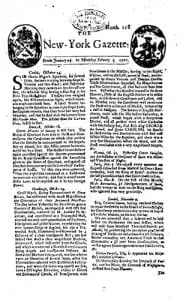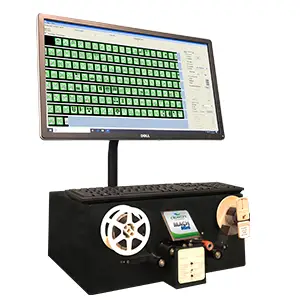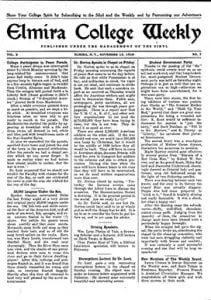Quantum Software Allows Historic New York Microfilm Newspaper Scanning Project to Continue Amid Pandemic
When time is seemingly standing still (quarantine blues, anyone?) yet moving so fast (how is it August already?!), there is not much else to do but start a project you know might take a while.
In attempting to run out the quarantine clock, I printed and intended to organize three years of photos from my phone. Instead, sitting with hard copy evidence of a life lived closer than six feet apart only deepened the shade of my blues and proved to me that working with even a personal archive is no small feat.
This realization helped me to truly appreciate the work of the New York State Historic Newspapers Project (NYS Historic Newspapers), which has not let COVID-19 slow its microfilm newspaper scanning progress. Created by the Northern New York Library Network (the Network) which is headquartered in Potsdam, NY, this project and its two-person team have safely and tenaciously been able to continue its 20-year-long mission to capture and make accessible historic New York newspapers from microfilm. In this blog, I’ll share how the project came to be and how the project has managed to save 293 years (and counting!) of New York State news.
About The Northern New York Library Network

The group is one of nine regional councils that provide support and resources to help member libraries meet their individual goals, for the ultimate benefit of library patrons. As of this writing, the Network serves 50+ member libraries including those in the academic, hospital, public, system, correctional facility, museum and special categories.
Origins of the NYS Historic Newspaper Project

In 2000, The Network’s Board of Trustees – which is made up of individuals from member organizations – recognized that many in the organization own microfilm collections and could benefit from a scanning and hosting project that would: a) offer digital preservation of valuable collections; b) relieve physical and sometimes fragile collections from constant use; and c) offer a user-friendly digital platform for researchers both within and without the North Country.
Chuck Henry, the Network’s Integrated Technologies Coordinator explains, “In its physical format, microfilm is difficult for beginners to use and often requires researchers to physically travel to where the collection is being stored.” Henry continues, “Through this initiative, libraries were, and are, given the opportunity to digitally preserve their newspaper collections. The program also allows for images to be accessed via a user-friendly digital research platform which would otherwise be a time-consuming and expensive endeavor for a library to undertake on their own.”
Large Scale Microfilm Newspaper Scanning
By 2001, the project was accepting its first microfilmed newspaper submissions.
Approved titles are submitted in one of two whttps://nyshistoricnewspapers.org/contribute/ays – as undigitized microfilm rolls to be scanned by the Network in Potsdam for a small per page fee or as previously digitized images which follow certain technical specifications. Most of the titles to date have been submitted as 35 mm 100’ and 200’ microfilm rolls.
Once scanned, the digital images are edited in-house and outsourced for Optical Character Recognition (OCR) processing which enables text-searchable images. Final images are then hosted on the NYS Historic Newspaper website (using the same software as the Library of Congress’ Chronicling America project) for the public to read and view free of charge.
Once underway, the microfilm newspaper scanning project proved enormously successful and the Network assisted several other New York library networks in beginning their own scanning initiatives. The Network eventually partnered with the Empire State Library Network to expand the effort beyond the North Country.
Hard work Requires Strong Hardware (and Software)
With the initial success of the project came the realization that the originally purchased microfilm scanner could not always produce the necessary image quality.
“An inherent challenge of projects like these,” explains Henry, “is that you never know what the quality of either the microfilm or the images on the microfilm will be until you put it on the scanner. As the project progressed, we found that we needed a scanner with higher capability to digitize from microfilm in any condition and which could coax the best image quality from images that may not have been captured correctly. This required advanced hardware and a full set of editing features to further execute the image quality needed.”
In 2003 – the same year The Crowley Company (Crowley) acquired Mekel Technology to add manufacturing to their digitization services portfolio – the Network chose a Mekel Technology MACH4 microfilm scanner to replace the original unit because of the Mekel’s ability to quickly produce quality images and allow for a wide variety of image editing tools to further enhance well-worn or low-quality film images.

“Brenna [the project’s lead imaging specialist] became an artist with the scanner early on and learned quickly how to use the customized Quantum software editing tools available to achieve great images,” remarks Henry. “We see a fair amount of film that is beat-to-heck from patron use. In a lot of cases, it’s the only copy available so we do the best we can and Quantum software helps us achieve that,” he emphasizes.
In 2019, after 16 busy years and five million images, the Network once again decided new technology advancements warranted an advanced scanner and returned to Crowley to purchase a MACH Mini microfilm scanner. Boasting a smaller footprint but equally powerful, the Crowley MACH Mini operates with the newest generation of Quantum software. Notes Henry, “The advancement in overall hardware and software technology is really what impressed us the most. Our post-processing workflow has streamlined with the new version of software, allowing us to scan more rolls and focus less on the back end editing.”
Where There’s a MACH There’s a Way

During the COVID-19 pandemic, the microfilm newspaper scanning has been able to continue thanks to remote possibilities of Quantum software, Henry explains. “Once quarantine started, the advantages of the MACH Mini became immediately apparent. Brenna has been able to scan rolls in the morning as the only person in the office and then remotely process the images in the afternoon from home – keeping the project moving forward while protecting everyone’s safety.” He continues, “We were able to adapt to the situation in a way that wouldn’t have been possible with any other scanner.”
As of this printing, the NYS Historic Newspaper Project is hosting over 10 million images (an estimated 7.5 of which have been captured by Brenna) from 7,000 newspaper titles dating from 1725 on their website. The popularity of the project is evident with an average of 50-60 thousand monthly visitors welcomed to the site.
Hope of a Better Future
Henry impressed to me that the radical change in newspapers themselves is blatantly apparent when looking at the collection as a whole. “Local news is now a smaller part of our newspapers but in the past, those stories were important for families to stay connected. The newspaper acted as the Twitter feed of the time and included small blurbs like a notice about a lost pair of spectacles, a family traveling to Attica over the weekend, someone leaving for college or other personal events.”
That is why projects like the NYS Historic Newspapers are so crucial in protecting and circulating stories, cultural perspectives and news of a time gone by. We applaud Brenna and Chuck for their work on this project and we hope that the knowledge spread by these collections can inspire and lead users to a brighter future.
With the recent toppling of statues in mind, my work in the archives and digital preservation world influences me to echo grade schoolers everywhere in saying paper “paper covers rock.” From personal photos to major news stories, primary sources and the original written word are some of the most valuable keys to preserving history’s stories, big and small.
Every Story Deserves Preservation. Crowley Can Help!
Crowley’s trusted scanning hardware, experienced imaging experts and network of industry professionals can support first-time and ongoing digitization projects for any collection size or type. For more information microfilm newspaper scanning products and services available from The Crowley Company, please call (240) 215-0224 or click here.

